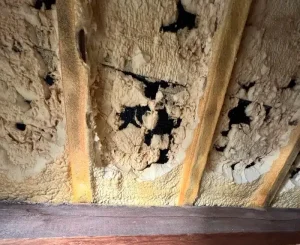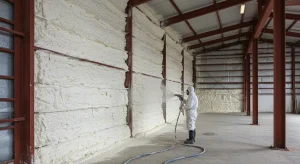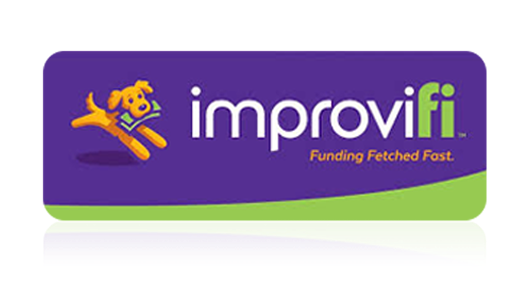At Flatland Roofing & Insulation, we speak with homeowners and builders every week who are trying to answer one big question: “How much does spray foam insulation actually cost in Texline, TX?” Whether you’re upgrading an existing property or building from the ground up, understanding insulation pricing can feel overwhelming.
We’re here to make it simple. From first-hand experience, we know that getting clear, accurate pricing information matters. It helps you budget smartly, avoid surprises, and get real results. That’s why we’ve created this guide to offer direct, transparent insights into spray foam insulation costs in Texline and what influences them. And yes, we break it all down using our local knowledge and experience in the Texas Panhandle.
By the end of this article, you’ll know exactly what to expect cost-wise, what factors will affect your total, and how to make confident decisions for your home or business backed by the team at Flatland Roofing & Insulation.
What Impacts Spray Foam Insulation Costs in Texline?
The cost of spray foam insulation isn’t a flat number because every home or project is different. That’s not a sidestep it’s the reality we work with every day. We see variations not just from one property to the next, but even from room to room within the same house.
Project Size and Scope in Texline
One of the biggest cost drivers is square footage. Spray foam insulation is typically priced per square foot, and larger projects benefit from better pricing efficiency. A 1,200 sq. ft. home attic costs significantly less per square foot than a small crawlspace retrofit.
For open-cell foam, average costs range from $0.90 to $1.50 per board foot. Closed-cell foam, which offers higher R-values and acts as a vapor barrier, typically ranges from $1.50 to $2.50 per board foot. We help clients determine which type makes the most sense based on their space and goals.
Accessibility and Installation Conditions
The ease of access to the installation site matters. If we’re insulating a brand-new build with open framing, our team can work faster and with fewer prep steps. But if we’re working in a tight, hard-to-reach attic or a space that requires cleanup or obstruction removal, labor time—and cost—goes up.
Texline’s climate and structural norms also affect how we prepare and apply foam. In many cases, we’re dealing with ranch-style homes or agricultural outbuildings, which call for different insulation strategies than multi-level properties in Amarillo or Lubbock.
Choosing Between Open-Cell and Closed-Cell Foam
Both types of spray foam offer insulation and air sealing in one application. The right choice depends on your needs, not hype. At Flatland Roofing & Insulation, we don’t push one over the other without a clear reason.
Open-Cell: Lighter, More Flexible, Less Expensive
Open-cell foam is ideal for interior applications like walls and attics where vapor permeability is acceptable or even desired. It’s lighter, more cost-effective, and expands more, which means it can seal larger gaps. We typically recommend open-cell for interior walls in Texline homes that don’t need heavy moisture resistance.
Closed-Cell: Higher R-Value, Better Moisture Barrier
Closed-cell foam is denser and more rigid. It insulates and adds structural strength, making it ideal for metal buildings, basements, or areas exposed to higher humidity. It costs more per board foot, but you get better thermal resistance. In Texline, we often install closed-cell foam in barns, workshops, and pole buildings where durability is critical.
Labor, Material & Equipment: What You’re Actually Paying For
When you pay for spray foam insulation, you’re not just buying a product—you’re paying for precision. It’s part chemistry, part craftsmanship.
Equipment and Trained Technicians
Spray foam requires specialized rigs, safety systems, and skilled applicators. Our crews are trained to get it right the first time applying foam evenly, at the right temperature, and to the correct depth. A bad spray job costs more to fix than to do right initially. We don’t cut corners.
Material Quality and Local Sourcing
We use high-performance spray foam sourced from top-tier manufacturers. Cheap foam exists, but we won’t install it. Period. Our materials are designed for long-term performance in Texas climates resisting moisture, mold, and heat loss year after year.
Local Building Needs and Spray Foam Costs in Texline
Texline’s wide temperature swings, dry air, and persistent winds make insulation a high-stakes investment. Cheap batt insulation doesn’t cut it in winter cold or summer heat.
How Texline Homes Benefit from Spray Foam
We often insulate ranch-style homes, detached garages, and outbuildings where air leakage is a major concern. Spray foam seals better than fiberglass or cellulose, which translates into lower utility bills and fewer drafts.
New Construction vs. Retrofit in Texline
Spray foam in new construction is faster and cheaper to install per square foot. Retrofit jobs require prep, removal, and more targeted application all of which affect pricing. When we insulate older Texline homes, we help clients identify where foam will have the biggest payoff.
Cost Breakdown by Home Area in Texline
Here’s a general pricing guide based on the areas we most commonly insulate:
- Attic: $2,000–$5,500 depending on size, access, and foam type
- Walls (exterior): $1.25–$2.50 per sq. ft. installed
- Crawlspace: $1,500–$4,000 depending on ventilation and access
- Metal building / barn: $3,000–$10,000+ based on size and structure
These numbers represent our real-world averages across Texline and surrounding areas. We provide tailored quotes after a site visit to ensure accuracy.
How to Get the Most Value
We help homeowners focus on high-impact zones first. Air sealing the attic or crawlspace usually delivers the highest energy savings per dollar spent. If you’re not ready for full-home insulation, that’s where we recommend starting.
Your Path to a Protected Home Starts Now with Flatland Roofing & Insulation
Understanding spray foam insulation costs gives you power—the power to invest wisely, avoid waste, and create lasting comfort in your Texline home or business. We’ve walked you through what goes into the pricing, what you’re actually paying for, and how to get the best value.
Whether you’re ready to insulate your entire property or want to focus on one high-impact area, we’re here to help you every step of the way. No upselling. No pressure. Just honest, expert service.
Give us a call at (806) 606-6794 or send a message to info@flatlandroofcoatings.com. Let’s make your space more efficient, comfortable, and protected—starting today.
Still Curious? Let’s Dive Deeper with Flatland Roofing & Insulation
Is spray foam insulation worth the investment in Texline?
Yes. For most homeowners, it reduces heating and cooling costs by 20–50%, depending on current insulation and air leakage levels. It also improves indoor comfort and air quality.
What’s the difference in energy savings between open-cell and closed-cell?
Closed-cell offers a higher R-value per inch, so you need less of it to achieve the same performance. But in some applications, the difference in energy savings is minimal—especially when air sealing is the primary benefit.
How long does spray foam insulation last?
Properly installed spray foam lasts 20–30 years or more. It doesn’t sag or settle like other materials, which means it keeps performing.
Can I insulate one area now and expand later?
Absolutely. Many of our clients start with attics or crawlspaces, then add wall insulation later. We help plan phased projects to fit your timeline and budget.
Will spray foam reduce noise inside my home?
Yes. Open-cell foam in walls and ceilings noticeably reduces sound transmission, especially from room to room.
Is financing available?
Yes. We work with local lenders and financing programs. Ask us about low-interest options designed for energy-efficient upgrades.
What if I have old insulation already?
No problem. We assess what can stay and what needs to be removed. In some cases, existing insulation can be left in place if it’s dry and mold-free.
Does Flatland Roofing & Insulation serve rural areas outside Texline?
We do. We regularly serve farms, ranches, and rural properties throughout the Texas Panhandle.
How do I get a quote?
Call us at (806) 606-6794 or email info@flatlandroofcoatings.com. We’ll schedule a no-pressure consultation and give you a clear, written quote.
How soon can you install?
Most projects are scheduled within 1–2 weeks, depending on size and location. We always aim for efficient scheduling without sacrificing quality.





